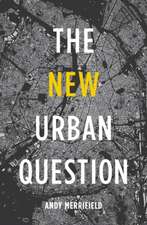Doing Urban Research: Applied Social Research Methods, cartea 33
Autor Gregory D. Andranovich, Gerry T. Riposaen Limba Engleză Paperback – 21 iun 1993
Din seria Applied Social Research Methods
- 26%
 Preț: 534.80 lei
Preț: 534.80 lei -
 Preț: 323.98 lei
Preț: 323.98 lei - 26%
 Preț: 537.02 lei
Preț: 537.02 lei - 22%
 Preț: 405.00 lei
Preț: 405.00 lei - 22%
 Preț: 405.12 lei
Preț: 405.12 lei -
 Preț: 457.79 lei
Preț: 457.79 lei - 15%
 Preț: 604.85 lei
Preț: 604.85 lei - 15%
 Preț: 605.03 lei
Preț: 605.03 lei - 20%
 Preț: 610.14 lei
Preț: 610.14 lei - 20%
 Preț: 610.80 lei
Preț: 610.80 lei - 15%
 Preț: 547.75 lei
Preț: 547.75 lei - 18%
 Preț: 786.24 lei
Preț: 786.24 lei - 15%
 Preț: 548.57 lei
Preț: 548.57 lei - 15%
 Preț: 604.71 lei
Preț: 604.71 lei - 15%
 Preț: 547.75 lei
Preț: 547.75 lei - 15%
 Preț: 549.22 lei
Preț: 549.22 lei - 15%
 Preț: 547.43 lei
Preț: 547.43 lei - 15%
 Preț: 550.06 lei
Preț: 550.06 lei - 20%
 Preț: 551.90 lei
Preț: 551.90 lei -
 Preț: 314.78 lei
Preț: 314.78 lei -
 Preț: 465.49 lei
Preț: 465.49 lei - 20%
 Preț: 608.46 lei
Preț: 608.46 lei - 15%
 Preț: 613.54 lei
Preț: 613.54 lei - 15%
 Preț: 549.05 lei
Preț: 549.05 lei - 15%
 Preț: 606.51 lei
Preț: 606.51 lei - 15%
 Preț: 549.22 lei
Preț: 549.22 lei - 20%
 Preț: 552.71 lei
Preț: 552.71 lei - 15%
 Preț: 550.06 lei
Preț: 550.06 lei - 15%
 Preț: 604.20 lei
Preț: 604.20 lei - 15%
 Preț: 605.36 lei
Preț: 605.36 lei - 15%
 Preț: 548.08 lei
Preț: 548.08 lei - 15%
 Preț: 606.15 lei
Preț: 606.15 lei - 15%
 Preț: 605.18 lei
Preț: 605.18 lei - 15%
 Preț: 611.09 lei
Preț: 611.09 lei - 15%
 Preț: 546.45 lei
Preț: 546.45 lei - 18%
 Preț: 716.88 lei
Preț: 716.88 lei - 15%
 Preț: 438.13 lei
Preț: 438.13 lei - 20%
 Preț: 553.37 lei
Preț: 553.37 lei - 18%
 Preț: 717.66 lei
Preț: 717.66 lei
Preț: 602.08 lei
Preț vechi: 708.33 lei
-15% Nou
Puncte Express: 903
Preț estimativ în valută:
115.22€ • 119.85$ • 95.12£
115.22€ • 119.85$ • 95.12£
Carte tipărită la comandă
Livrare economică 14-28 aprilie
Preluare comenzi: 021 569.72.76
Specificații
ISBN-13: 9780803939899
ISBN-10: 0803939892
Pagini: 115
Dimensiuni: 141 x 217 x 9 mm
Greutate: 0.14 kg
Ediția:1
Editura: SAGE Publications
Colecția Sage Publications, Inc
Seria Applied Social Research Methods
Locul publicării:Thousand Oaks, United States
ISBN-10: 0803939892
Pagini: 115
Dimensiuni: 141 x 217 x 9 mm
Greutate: 0.14 kg
Ediția:1
Editura: SAGE Publications
Colecția Sage Publications, Inc
Seria Applied Social Research Methods
Locul publicării:Thousand Oaks, United States
Cuprins
The Nature of Applied Urban Research
The Urban Setting
Levels of Analysis
Preparing for Applied Urban Research
Research Design
Data Collection in the Urban Setting
Reporting Your Research
Prospectus for Applied Urban Research
The Urban Setting
Levels of Analysis
Preparing for Applied Urban Research
Research Design
Data Collection in the Urban Setting
Reporting Your Research
Prospectus for Applied Urban Research
Notă biografică
Descriere
What is the current spatial form and structure of our urban environment, and how can we study the factors and forces that account for the specific structure of urban space, its social and political processes, population distribution and land use? Addressing these and other issues, the authors highlight specific research questions and the ways in which they can be approached by offering a framework for considering the various ways in which to do urban research. Covering such topics as how to choose a research design, secondary research methods for data collection and how to enhance research utilization, the authors demonstrate ways to pair research questions with specific levels of analysis, such as neighbourhood, city or national level.















